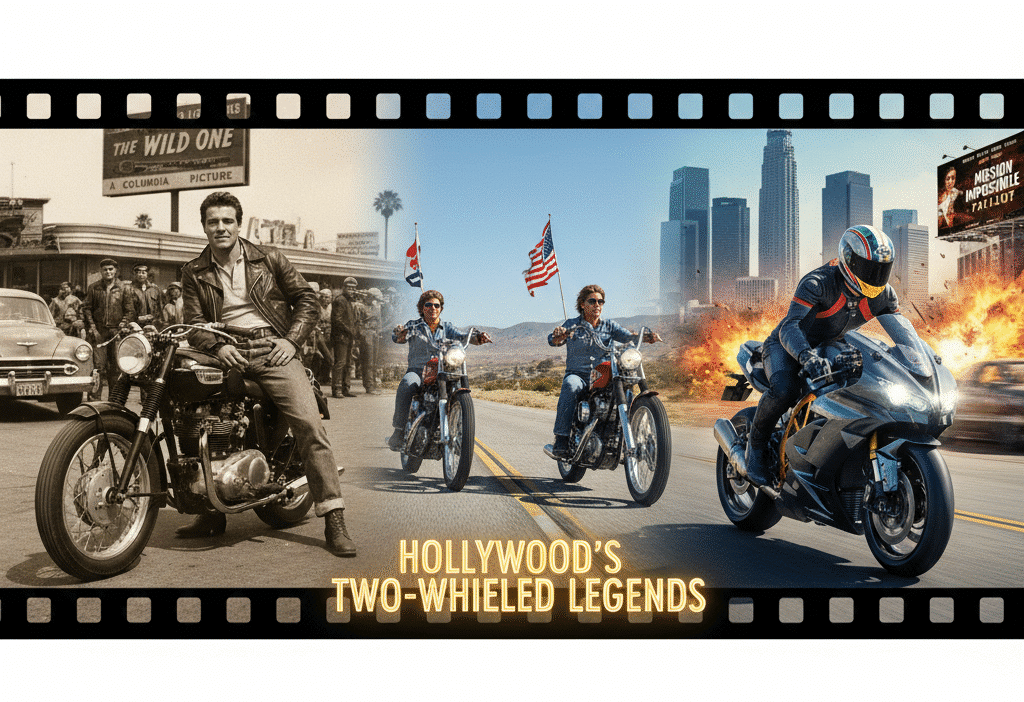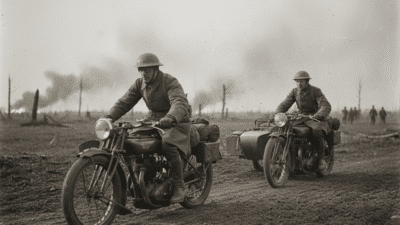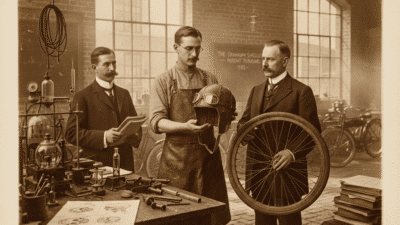From the moment Marlon Brando first glared from the saddle of his Triumph Thunderbird in The Wild One, motorcycles in Hollywood: From Marlon Brando to modern films have been far more than mere vehicles. They’ve been extensions of character, symbols of rebellion, freedom, and raw power, carving an indelible mark on cinematic history and the collective imagination. These two-wheeled machines have roared their way through countless genres, evolving from counter-culture icons to high-tech instruments of justice and destruction, constantly adapting to the ever-changing landscape of storytelling.
There’s something inherently captivating about a motorcycle on screen. It’s the visceral sound of the engine, the blur of speed, the sheer vulnerability yet undeniable coolness of the rider. Hollywood quickly understood this potent combination, transforming mundane mechanics into mythic beasts that propel narratives forward and embed themselves in our cultural memory. Let’s take a wild ride through the decades, exploring how motorcycles have cemented their legendary status in the annals of cinema.
The Rebel Yell: Brando’s Era and the Birth of the Biker Anti-Hero
Before The Wild One hit screens in 1953, motorcycles were often seen as practical transport or props for stuntmen. Marlon Brando changed everything. As Johnny Strabler, leader of the Black Rebel Motorcycle Club, Brando didn’t just ride a bike; he became the bike. His slumped posture, the leather jacket, the defiant scowl – it all coalesced into an image of rebellious youth that resonated deeply and, frankly, terrified many parents.
Johnny’s motorcycle, a Triumph Thunderbird 6T, wasn’t just a means of transportation; it was a character in itself. It symbolized his alienation, his rejection of societal norms, and his raw, untamed spirit. The film, loosely based on real-life biker gang incidents, depicted a generation grappling with post-war anxieties, finding solace and identity in the roar of an engine and the camaraderie of the open road. It cemented the archetype of the “biker outlaw” that would influence fashion, music, and subsequent cinema for decades. This wasn’t just a movie; it was a cultural phenomenon that defined cool for a generation.

The impact was immediate and profound. Suddenly, motorcycles weren’t just for enthusiasts; they were for rebels, for those who dared to live outside the lines. This rebellious image wasn’t always positive, leading to some moral panic, but it undeniably elevated the motorcycle to a symbol of individualism and a powerful cinematic tool.
Roaring into the Counter-Culture: Easy Rider and Beyond
The seeds planted by Brando blossomed spectacularly with Easy Rider in 1969. This landmark film, starring Peter Fonda as Wyatt (“Captain America”) and Dennis Hopper as Billy, took the motorcycle’s symbolic power to new heights. Their custom choppers – especially Captain America’s iconic stars-and-stripes-painted Harley-Davidson Panhead – weren’t just vehicles; they were freedom machines, carrying them across America in search of a nebulous, elusive American dream.
Easy Rider captured the zeitgeist of the late 1960s: the counter-culture movement, the disillusionment with mainstream society, and the yearning for spiritual and literal liberation. The film’s sprawling cross-country journey, accompanied by a killer soundtrack, became a visual manifesto for a generation. It showed the romance of the open road, the beauty of untouched landscapes, and the stark reality of intolerance encountered along the way. The bikes themselves became characters, each dent and scratch telling a story. Their tragic end underscored the fragility of that freedom in a society often hostile to those who dared to be different.
This film solidified the chopper as an icon, influencing motorcycle customization for years to come. It wasn’t just about speed; it was about style, personal expression, and the statement your ride made about who you were.
Steve McQueen: The King of Cool on Two Wheels
While Brando brought the rebel, Steve McQueen brought the pure, unadulterated cool. Known for performing his own stunts, McQueen’s most legendary motorcycle moment arguably came in The Great Escape (1963). Leaping a barbed-wire fence on a modified Triumph TR6 Trophy, he cemented his status as a true action hero and a motorcycle legend. Though famously a double performed the actual jump, McQueen’s riding leading up to it, and his overall persona, made the moment iconic.
McQueen’s connection to motorcycles extended beyond the screen; he was an avid racer and collector in real life. This authenticity added layers to his on-screen portrayals, making every scene he spent on a bike feel genuinely thrilling. His love for motorcycling was infectious, inspiring countless fans to embrace the two-wheeled lifestyle.

Action, Speed, and Sci-Fi: Motorcycles in the 80s and 90s
As cinema evolved, so did the role of motorcycles. The 80s and 90s saw bikes transformed from symbols of quiet rebellion into tools of high-octane action, often paired with the era’s biggest stars.
Mad Max and the Post-Apocalyptic Ride
George Miller’s Mad Max (1979) introduced us to a desolate future where gasoline was king and roads were ruled by ruthless biker gangs. While Max Rockatansky himself often drove a supercharged V8 Interceptor, the marauding gangs on their modified Kawasaki and Honda bikes were integral to the film’s gritty, post-apocalyptic aesthetic. These motorcycles were stripped-down, brutal machines, reflecting the desperation and violence of their world. They weren’t about freedom, but survival and dominance. The film’s influence on costume design and the portrayal of dystopia on two wheels is still felt today.
Top Gun’s Need for Speed
When Tom Cruise as Maverick tore down the runway alongside a jet in Top Gun (1986) on his Kawasaki GPZ900R, it was pure, unadulterated 80s cool. This wasn’t about rebellion in the traditional sense, but about youthful exuberance, speed, and defying limits. The motorcycle was an extension of Maverick’s personality: fast, daring, and always pushing the envelope. It was a simpler, more exhilarating portrayal, cementing the sports bike as a symbol of adrenaline-fueled adventure.
Terminator 2: Judgment Day’s Iconic Ride
One of the most memorable pairings of man and machine came in Terminator 2: Judgment Day (1991). Arnold Schwarzenegger, as the reprogrammed T-800, riding a Harley-Davidson Fat Boy, became an instant icon. This wasn’t a sleek sports bike, but a heavy, powerful cruiser, perfectly matching the Terminator’s indestructible, imposing presence. The shot of him, shotgun in hand, on the bike, became one of the defining images of 90s action cinema. The Fat Boy itself saw a massive surge in popularity, a testament to Hollywood’s power to influence consumer trends. It proved that a powerful motorcycle could signify unshakeable resolve as much as wild freedom.

Harley Davidson and the Marlboro Man
This 1991 buddy action film starring Mickey Rourke and Don Johnson might not be a critical darling, but it epitomized the “outlaw biker” aesthetic for a new generation. With custom Harleys, leather, and a plot centered around friendship and a fight against corporate greed, it leaned heavily into the romanticized vision of the American biker. It celebrated a certain rugged individualism and a defiance of the mundane, capturing the spirit that Brando had first ignited decades prior.
Modern Blockbusters: Evolving Roles for the Two-Wheeled Star
The 21st century has seen motorcycles continue their cinematic journey, adapting to more sophisticated storytelling, cutting-edge special effects, and diverse genres. From futuristic Batpods to high-speed spy chase sequences, bikes remain a crucial element in modern filmmaking.
The Dark Knight and the Batpod
Christopher Nolan’s The Dark Knight (2008) gave us one of the most innovative cinematic motorcycles ever: the Batpod. This heavily armored, weaponized, and highly agile two-wheeled vehicle emerged from the wreckage of the Tumbler Batmobile, serving as Batman’s escape and pursuit vehicle. Its unique design, with oversized wheels and no visible handlebars, was a marvel of fictional engineering. The Batpod symbolized Batman’s resourcefulness and technological prowess, showing that motorcycles could be more than just standard vehicles; they could be fantastical extensions of a superhero’s arsenal.
Mission: Impossible and the Art of the Motorcycle Chase
Tom Cruise, much like Steve McQueen, is renowned for performing his own jaw-dropping stunts, and many of his most memorable moments involve motorcycles. The Mission: Impossible franchise has consistently delivered some of the most thrilling and expertly choreographed motorcycle chases in recent memory. Whether it’s the intense pursuit through the streets of Casablanca in Rogue Nation (2015) on a BMW S 1000 RR, or the white-knuckle ride through Paris in Fallout (2018), Cruise demonstrates an unparalleled command of the bike, making these sequences incredibly visceral. These films showcase the motorcycle’s agility and speed, making it perfect for high-stakes espionage.
John Wick: Style, Precision, and Brutality
The John Wick franchise is a masterclass in modern action choreography, and motorcycles play a significant role in its sleek, stylized world. Keanu Reeves’ John Wick often utilizes powerful, custom motorcycles for swift transport and brutal combat. These bikes aren’t just for escaping; they’re integrated into the “gun-fu” fighting style, allowing Wick to perform incredible feats of agility and violence. The bikes in John Wick embody a modern, understated cool – powerful, fast, and deadly, much like the Baba Yaga himself.
Marvel Cinematic Universe: Black Widow’s Signature Ride
In the sprawling Marvel Cinematic Universe, various characters have ridden motorcycles, but perhaps none as consistently as Black Widow. Scarlett Johansson’s portrayal often featured her on sleek, powerful bikes, particularly in films like Captain America: The Winter Soldier and Avengers: Age of Ultron. For Black Widow, the motorcycle became an extension of her character – agile, dangerous, and incredibly capable. It enhanced her spy persona, emphasizing her ability to navigate chaotic environments with speed and precision.

The Enduring Symbolism of the Motorcycle on Screen
Beyond the thrilling chases and iconic imagery, motorcycles in film carry deep symbolic weight, tapping into universal human desires.
Freedom and the Open Road
This is arguably the most potent and consistent symbol. The motorcycle represents escape from the mundane, the call of adventure, and the promise of self-discovery on the open highway. It’s a literal vehicle for journeys, and a metaphorical one for personal transformation. From Captain America’s quest for truth to any character simply needing to get away, the bike offers an immediate sense of liberation. It’s a reminder that sometimes, the best way to clear your head is to hit the road and let the wind carry your worries away.
Rebellion and the Outlaw Spirit
From Brando to modern anti-heroes, the motorcycle often signifies a rejection of societal norms. It’s the choice of characters who live by their own rules, who question authority, and who operate outside the conventional system. This can be romanticized, as in Easy Rider, or brutally depicted, as in Mad Max. This allure of the outlaw continues to make bikes a compelling choice for characters who challenge the status quo.
Power, Speed, and Control
A powerful motorcycle conveys strength and dominance. In action films, it’s a tool for quick getaways, rapid pursuits, and showing off incredible skill. The rider has complete control over a machine that can be both beautiful and deadly, translating into a powerful on-screen presence. Whether it’s a superhero or a hitman, the ability to control such a machine adds to their mystique and capability.
Identity and Character Extension
Often, a character’s choice of motorcycle tells us a lot about them. A classic cruiser might suggest a traditionalist or a rugged individual, a sports bike, a thrill-seeker or a professional racer. A custom chopper speaks of a unique personality. The bike becomes an extension of their identity, a visual shorthand for who they are.
Pros and Cons
| Pros | Cons |
|---|---|
| – Iconic Imagery: Creates visually stunning and memorable scenes. | – Perpetuates Stereotypes: Can reinforce negative biker gang imagery. |
| – Enhances Character: Reflects personality, rebellion, or freedom. | – Safety Concerns (Stunts): High risk for stunt performers and actors. |
| – Dynamic Action: Ideal for fast-paced chases and thrilling stunts. | – Limited Narrative Depth: Sometimes just a cool prop, not integral to plot. |
| – Cultural Impact: Influences fashion, music, and motorcycle sales. | – Technical Accuracy: Film depictions often sacrifice realism for drama. |
| – Symbolic Richness: Represents freedom, danger, power, individualism. | – Maintenance Demands: Real-world motorcycles need care, like checking chain tension or changing oil, which isn’t cinematic. |
The Craft Behind the Ride: Making Motorcycle Scenes Shine
It’s not just the bike or the rider; it’s the intricate craft that goes into making a motorcycle scene truly unforgettable.
Cinematography and Pacing
Filming a motorcycle chase requires a keen eye for motion, speed, and perspective. Dynamic camera angles, often low to the ground or mounted directly on the bike, immerse the audience in the action. Slow-motion can highlight a crucial moment, while rapid cuts intensify the pace. The sound design, from the roar of the engine to the screech of tires, is equally vital in conveying excitement.
Stunt Work and Practical Effects
While CGI has its place, the most impactful motorcycle stunts are often achieved practically. Professional stunt riders, often pushing the limits of what’s possible, bring authenticity to these sequences. The preparation is meticulous, involving careful planning, rigorous training, and advanced safety measures. Whether it’s a controlled slide or a precise jump, the effort behind these real-world stunts is immense. It’s truly incredible how much skill goes into making a motorcycle dance on screen. For instance, ensuring your actual motorcycle is in top shape, from inspecting brake pads to checking tire pressure, is crucial for both performance and safety, whether you’re a stunt performer or just riding on the open road.
The Evolution of the Bike on Screen
As technology progresses, so too do the motorcycles we see in films. From classic cruisers and choppers to high-tech sports bikes and futuristic concept vehicles like the Batpod, cinema reflects and sometimes even inspires advancements in motorcycle design. The continuous desire for fresh visuals means filmmakers are always looking for the next exciting two-wheeled marvel.

The Lasting Legacy and Cultural Influence
Hollywood’s love affair with motorcycles isn’t just about entertainment; it has a tangible impact on the real world. Films inspire dreams, shape perceptions, and even influence purchasing decisions. After Easy Rider, custom chopper sales soared. Post-Terminator 2, the Harley-Davidson Fat Boy became a legend. Movies show us what’s possible, what’s cool, and what dreams look like on two wheels.
This influence extends to fashion, music, and the very culture of motorcycling itself. The leather jacket, the denim vest, the open-faced helmet – many iconic biker styles trace their roots back to the silver screen. More profoundly, films continue to perpetuate the notion of the motorcycle as a symbol of personal freedom and a powerful statement of identity. For anyone passionate about their ride, understanding how to keep it running smoothly is key. You might want to check out how to check and change motorcycle oil to ensure your machine is always ready for its close-up, whether on the road or in your imagination.
Conclusion
From the brooding intensity of Marlon Brando’s Johnny Strabler to the futuristic agility of Batman’s Batpod and the death-defying stunts of Ethan Hunt, motorcycles have been a constant, thrilling presence in Hollywood. They’ve evolved from symbols of post-war rebellion to complex characters in their own right, adapting to every genre and cinematic innovation imaginable.
These two-wheeled stars aren’t just props; they are essential storytelling devices, embodying freedom, danger, power, and individuality. They thrill us, inspire us, and often leave us dreaming of the open road. As long as there are stories to tell and audiences to captivate, the roar of a motorcycle will undoubtedly continue to echo through the grand halls of Hollywood. So, what’s your favorite movie bike moment? The one that truly made you feel the wind in your hair and the rumble in your chest?
Frequently Asked Questions
What was the first iconic motorcycle movie?
The Wild One (1953), starring Marlon Brando on a Triumph Thunderbird 6T, is widely considered the first film to establish the iconic “biker outlaw” image in cinema, significantly influencing motorcycle culture.
How did Easy Rider impact motorcycle culture?
Easy Rider (1969) profoundly impacted motorcycle culture by romanticizing the open road, custom choppers (like Captain America’s Harley-Davidson), and the counter-culture movement, inspiring a generation of riders and customizers.
Do actors usually perform their own motorcycle stunts?
While some actors, notably Steve McQueen and Tom Cruise, are famous for performing many of their own motorcycle stunts, complex and dangerous sequences are typically handled by highly skilled professional stunt riders for safety reasons.
What motorcycle did Arnold Schwarzenegger ride in Terminator 2?
Arnold Schwarzenegger’s T-800 character in Terminator 2: Judgment Day famously rode a Harley-Davidson Fat Boy, which saw a significant boost in popularity after the film’s release.
How have motorcycles in films changed over time?
Motorcycles in films have evolved from symbols of rebellion in the mid-20th century to tools of high-octane action in the 80s and 90s, and now feature as sophisticated, often technologically advanced machines in modern blockbusters, adapting to diverse genres and storytelling needs.
What makes a motorcycle scene so engaging in movies?
Engaging motorcycle scenes combine dynamic cinematography (e.g., low angles, on-bike cameras), realistic stunt work (often practical effects), immersive sound design (engine roars, tire screeches), and the inherent symbolic power of the motorcycle itself, conveying speed, freedom, or danger.



